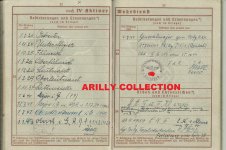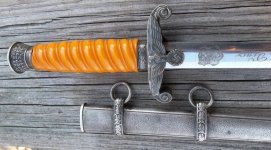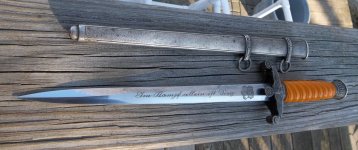My father in law brought this home from ww2.I have finally been able to crack whos dagger it was after all these years.I shouldnt say me a fellow board member on German Helmet Walhalla Stefan did.The General is a interesting professional Military man and the last to be so in his family line.There was also a book written about him recently 2014.The acid etched coat of arms on the dagger matches his family coat of arms from 1713.He was also involved in the plot to kill Hitler in 1944.The motto on the dagger reads
Im Kampf allein ist Sieg - victory is in the fight alone
Fabricius gen Schmidt on old town coat of arms of 1713 Hans Georg Schmidt from old town
Schmidt from Altenstadts father Ulrich was Adjutant to field marshal von Mackensen, the Commander of the life Hussar Brigade in Danzig-Langfuhr as major. His grandfather Eduard Schmidt of old town was Prussian Generalmajor. Hans Georg grew up in Gdansk and the parental Manor of medunischken in the District of Angerapp. He was married to a Danish woman and had three children. He attended the war school after graduating and became a career officer.
in 1923, he entered (Prussian) Cavalry Regiment of the Reichswehr in the 4th. [1] in 1939, he was quartermaster of 18th Army Corps. He held the post of the first Generalstabsoffiziers of the 18th Infantry Division in November 1939. See Eduard Wagner, the quartermaster general in the Supreme command of the army, he was head of the Department of management of the war in the summer of 1940. In that post, he was responsible for basic administrative commands for dealing with the civilian population of the Soviet Union. At the same time, he had to make important coordination role with the imperial authorities and NSDAP party places. In August 1943, he transferred to the Italian front. There, he served as Chief of staff of the combat units (→ battle of Monte Cassino). He suffered injuries [2] in a car accident [3] injuries and died in the Hospital of bad Tölz from a pulmonary embolism. July 1, 1944, three weeks before his death, he was promoted to major general. [4]
Researchers Schmidt of Altenstadt thought long an advocate of a moderate policy of occupation. He is variously associated with circles of the military resistance in connection. [5] [6] [7] [8] [9] [10] in September 1942 he had knowledge of plans by Claus Schenk Graf von Stauffenberg to eliminate Hitler. [11] [12] also tried Schmidt by old city alongside with his friend [13] Stauffenberg win Commander of individual Army groups for a political upheaval. [14] he took the view that the coup could only succeed if you kill Hitler, rather than take him prisoner end of 1941. Only then, it broke the oath which the soldiers of the Wehrmacht on Hilter had sworn. [15] [16] the backing of the generals for the coup from old town but for low estimated. [17]
As head of the Department of administration of the war he was however involved in the Holocaust, he was, for example, among those who arranged the massacre at Kamenets-Podolsk on August 25, 1941. [18] he embarked full first the disastrous occupation of the Wehrmacht to own, in large parts, he organized themselves. Only after the advance of the German troops faltered, he advised a more moderate attitude towards the non-Russian populations. [19]
In February 1942, major I.g.. Schmidt from old town to the OKH formulated proposals for a change in war policy. The Russian resistance could be undermined by the supply situation in the population would be improved. Local associations to fight against Bolshevism should be placed as well. The kolkhoz system should be dissolved and therefore land ownership to farmers possible, also the religious needs of the population should be taken into account. From September 1942 called old city by Hitler the setting of the persecution of Jews. [21]
With the quartermaster general Lieutenant General Eduard Wagner and major Graf von Stauffenberg set up end of 1942 in the Caucasus a political self-government Schmidt of old town for the Caucasian peoples (Georgians, Azerbaijanis, Armenians, and more). With the guarantee of complete political independence, Wagner, Stauffenberg and old city hoped to win the Caucasians for cooperation. This attempt of political warfare is known later as "Caucasian experiment". In the conquered territories, the people should be offered an attractive alternative to Stalin's Soviet system.
After the population of the occupied territories was won, local associations to fight against Stalin's Soviet regime should be placed. Altenstadts Department administration of war and the Organization Department of the General staff of the army ran the establishment of an army under the Russian General Wlassov in the way. So Hitler made without knowledge 1942-43 under the slogan "Russia can be defeated only by Russians", 1 million former Red Army soldiers in voluntary associations in the year. Schmidt of Altenstadt was believes that the Russian people about the area of the front could also be mobilized to fight against Stalin. The fight in the depth of the Russian room could be successfully only by Russians.
In January 1943 Lieutenant-Colonel I.g.. Schmidt from old town a memorandum, calling a ban of manhunts and a fundamentally better treatment of Russian workers again, as he considered still better coverage of the population in the occupied territories with food as necessary. [24] [25] this memorandum was presented also Hitler and propaganda Minister Goebbels, without that at this thinking took place. [26] Hitler should have foamed proposals [infuriated] about Schmidt from Altenstadts, when he field Marshal Wilhelm Keitel got presented them by the Chief of the General staff of the army. [27] other officers and officials consider joined, that the war only with a shift away from the previous forced - and colonial methods is to win. This included the idea of a "new Europe", which should preserve the autonomy of the peoples in the East. [28]
After the failed attempt to assassinate Hitler on 20 July 1944 the propaganda Department and other departments were a direct involvement of Sai by Altenstadts on attempting to revolt. [29] [30] on the following day was the good Medunischken of family in East Prussia searches and the father Schmidt from Altenstadts for two days being interrogated by the Gestapo. [31] witnesses believe that major-General Hans-Georg Schmidt from old town only by his death in the hospital people involved escaped the fate of the other 200 in the plot of 20 July 1944 on 25 July 1944. [32] Hans Georg Schmidt from Altenstadts widow married after World War II the General (ret'd) Gerhard Feyerabend.
Military biography
Service entry date: 01.04.1923
Troops according to messages:
01.05.1927 6 Squadron / 4th Prussian Cavalry Regiment
01.05.1928 01.05.1929 2.Eskadron / 4th Prussian Cavalry Regiment
01.05.1931 01.05.1932 1.Eskadron / 4th Prussian Cavalry Regiment
03.01.1939 05.11.1939 general staff XVIII Army Corps Salzburg
10.07.1940 Rod 18th Infantry Division
06.10.1943 20.01.1944 General command LI mountain Corps.
22.01.1944 25.07.1944 Generalkommando XIV Panzer Corps.
Hospital stays:
18.06.1944 reserve hospital Tegernsee, part hospital Schwaighof
13.07.1944 reserve hospital bad Tölz
25.07.1944 died in RES.-hospital bad Tölz
Service levels and promotions:
01.08.1924 of private
01.11.1924 Sergeant
01.10.1925 Ensign
01.08.1926 officer
01.12.1926 Lieutenant
01.02.1929 Lieutenant
01.11.1934 captain
01.06.1940 major I.g..
02.03.1942 Oberstleutnant I.g..
06.10.1943 Colonel I.g..
01.07.1944 major-general
Awards and decorations:
29.09.1939 iron cross II class
18.05.1940 iron cross I class
08.05.1944 German cross in gold
Front inserts:
September 1939 - November 1939 Poland as a quartermaster 18th Army Corps
November 1939 - July 1940 Western front as 1st General staff officer of 18th Division
October 1942 – November 1942 Eastern front as a regiment leader 82nd Division
August 1943 - January 1944 Italy as Chief of the General staff LI mountain Corps
January 1944 - June 1944 Italy as Chief of the General staff XIV Panzer Corps.
Use non-combat:
July 1940 - June 1943 Department Chief of the General staff of the Army
Im Kampf allein ist Sieg - victory is in the fight alone
Fabricius gen Schmidt on old town coat of arms of 1713 Hans Georg Schmidt from old town
Schmidt from Altenstadts father Ulrich was Adjutant to field marshal von Mackensen, the Commander of the life Hussar Brigade in Danzig-Langfuhr as major. His grandfather Eduard Schmidt of old town was Prussian Generalmajor. Hans Georg grew up in Gdansk and the parental Manor of medunischken in the District of Angerapp. He was married to a Danish woman and had three children. He attended the war school after graduating and became a career officer.
in 1923, he entered (Prussian) Cavalry Regiment of the Reichswehr in the 4th. [1] in 1939, he was quartermaster of 18th Army Corps. He held the post of the first Generalstabsoffiziers of the 18th Infantry Division in November 1939. See Eduard Wagner, the quartermaster general in the Supreme command of the army, he was head of the Department of management of the war in the summer of 1940. In that post, he was responsible for basic administrative commands for dealing with the civilian population of the Soviet Union. At the same time, he had to make important coordination role with the imperial authorities and NSDAP party places. In August 1943, he transferred to the Italian front. There, he served as Chief of staff of the combat units (→ battle of Monte Cassino). He suffered injuries [2] in a car accident [3] injuries and died in the Hospital of bad Tölz from a pulmonary embolism. July 1, 1944, three weeks before his death, he was promoted to major general. [4]
Researchers Schmidt of Altenstadt thought long an advocate of a moderate policy of occupation. He is variously associated with circles of the military resistance in connection. [5] [6] [7] [8] [9] [10] in September 1942 he had knowledge of plans by Claus Schenk Graf von Stauffenberg to eliminate Hitler. [11] [12] also tried Schmidt by old city alongside with his friend [13] Stauffenberg win Commander of individual Army groups for a political upheaval. [14] he took the view that the coup could only succeed if you kill Hitler, rather than take him prisoner end of 1941. Only then, it broke the oath which the soldiers of the Wehrmacht on Hilter had sworn. [15] [16] the backing of the generals for the coup from old town but for low estimated. [17]
As head of the Department of administration of the war he was however involved in the Holocaust, he was, for example, among those who arranged the massacre at Kamenets-Podolsk on August 25, 1941. [18] he embarked full first the disastrous occupation of the Wehrmacht to own, in large parts, he organized themselves. Only after the advance of the German troops faltered, he advised a more moderate attitude towards the non-Russian populations. [19]
In February 1942, major I.g.. Schmidt from old town to the OKH formulated proposals for a change in war policy. The Russian resistance could be undermined by the supply situation in the population would be improved. Local associations to fight against Bolshevism should be placed as well. The kolkhoz system should be dissolved and therefore land ownership to farmers possible, also the religious needs of the population should be taken into account. From September 1942 called old city by Hitler the setting of the persecution of Jews. [21]
With the quartermaster general Lieutenant General Eduard Wagner and major Graf von Stauffenberg set up end of 1942 in the Caucasus a political self-government Schmidt of old town for the Caucasian peoples (Georgians, Azerbaijanis, Armenians, and more). With the guarantee of complete political independence, Wagner, Stauffenberg and old city hoped to win the Caucasians for cooperation. This attempt of political warfare is known later as "Caucasian experiment". In the conquered territories, the people should be offered an attractive alternative to Stalin's Soviet system.
After the population of the occupied territories was won, local associations to fight against Stalin's Soviet regime should be placed. Altenstadts Department administration of war and the Organization Department of the General staff of the army ran the establishment of an army under the Russian General Wlassov in the way. So Hitler made without knowledge 1942-43 under the slogan "Russia can be defeated only by Russians", 1 million former Red Army soldiers in voluntary associations in the year. Schmidt of Altenstadt was believes that the Russian people about the area of the front could also be mobilized to fight against Stalin. The fight in the depth of the Russian room could be successfully only by Russians.
In January 1943 Lieutenant-Colonel I.g.. Schmidt from old town a memorandum, calling a ban of manhunts and a fundamentally better treatment of Russian workers again, as he considered still better coverage of the population in the occupied territories with food as necessary. [24] [25] this memorandum was presented also Hitler and propaganda Minister Goebbels, without that at this thinking took place. [26] Hitler should have foamed proposals [infuriated] about Schmidt from Altenstadts, when he field Marshal Wilhelm Keitel got presented them by the Chief of the General staff of the army. [27] other officers and officials consider joined, that the war only with a shift away from the previous forced - and colonial methods is to win. This included the idea of a "new Europe", which should preserve the autonomy of the peoples in the East. [28]
After the failed attempt to assassinate Hitler on 20 July 1944 the propaganda Department and other departments were a direct involvement of Sai by Altenstadts on attempting to revolt. [29] [30] on the following day was the good Medunischken of family in East Prussia searches and the father Schmidt from Altenstadts for two days being interrogated by the Gestapo. [31] witnesses believe that major-General Hans-Georg Schmidt from old town only by his death in the hospital people involved escaped the fate of the other 200 in the plot of 20 July 1944 on 25 July 1944. [32] Hans Georg Schmidt from Altenstadts widow married after World War II the General (ret'd) Gerhard Feyerabend.
Military biography
Service entry date: 01.04.1923
Troops according to messages:
01.05.1927 6 Squadron / 4th Prussian Cavalry Regiment
01.05.1928 01.05.1929 2.Eskadron / 4th Prussian Cavalry Regiment
01.05.1931 01.05.1932 1.Eskadron / 4th Prussian Cavalry Regiment
03.01.1939 05.11.1939 general staff XVIII Army Corps Salzburg
10.07.1940 Rod 18th Infantry Division
06.10.1943 20.01.1944 General command LI mountain Corps.
22.01.1944 25.07.1944 Generalkommando XIV Panzer Corps.
Hospital stays:
18.06.1944 reserve hospital Tegernsee, part hospital Schwaighof
13.07.1944 reserve hospital bad Tölz
25.07.1944 died in RES.-hospital bad Tölz
Service levels and promotions:
01.08.1924 of private
01.11.1924 Sergeant
01.10.1925 Ensign
01.08.1926 officer
01.12.1926 Lieutenant
01.02.1929 Lieutenant
01.11.1934 captain
01.06.1940 major I.g..
02.03.1942 Oberstleutnant I.g..
06.10.1943 Colonel I.g..
01.07.1944 major-general
Awards and decorations:
29.09.1939 iron cross II class
18.05.1940 iron cross I class
08.05.1944 German cross in gold
Front inserts:
September 1939 - November 1939 Poland as a quartermaster 18th Army Corps
November 1939 - July 1940 Western front as 1st General staff officer of 18th Division
October 1942 – November 1942 Eastern front as a regiment leader 82nd Division
August 1943 - January 1944 Italy as Chief of the General staff LI mountain Corps
January 1944 - June 1944 Italy as Chief of the General staff XIV Panzer Corps.
Use non-combat:
July 1940 - June 1943 Department Chief of the General staff of the Army
Attachments

PICT4223.jpg
284.9 KBViews: 83
PICT4222.jpg
317.6 KBViews: 79
PICT4218.jpg
314.3 KBViews: 71
PICT4225.jpg
311.2 KBViews: 60
Germdag4.JPG
39.6 KBViews: 65
Germdag3.JPG
38.1 KBViews: 51
Oberst_i.G._Hans_Georg_Schmidt_von_Altestadt.JPG
13.2 KBViews: 71
post-16757-0-42329500-1489733336.png
166.8 KBViews: 54
Officer_(General_Staff)_Schmidt_von_Altenstadt_at_Wolfsschanze.JPG
15 KBViews: 64
12610_a25_7b.jpg
87.9 KBViews: 90
75237_a25_7d.jpg
135.2 KBViews: 41




